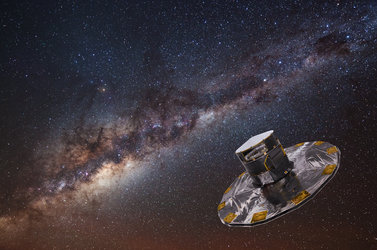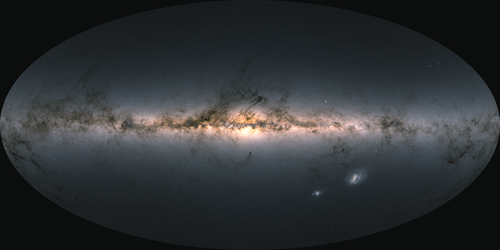Global Gaia campaign reveals secrets of stellar pair
A 500-day global observation campaign spearheaded more than three years ago by ESA’s galaxy-mapping powerhouse Gaia has provided unprecedented insights into the binary system of stars that caused an unusual brightening of an even more distant star.
The brightening of the star, located in the Cygnus constellation, was first spotted in August 2016 by the Gaia Photometric Science Alerts programme.
This system, maintained by the Institute of Astronomy at the University of Cambridge, UK, scans daily the huge amount of data coming from Gaia and alerts astronomers to the appearance of new sources or unusual brightness variations in known ones, so that they can quickly point other ground and space-based telescopes to study them in detail. The phenomena may include supernova explosions and other stellar outbursts.
In this particular instance, follow-up observations performed with more than 50 telescopes worldwide revealed that the source – since then named Gaia16aye – was behaving in a rather strange way.
“We saw the star getting brighter and brighter and then, within one day, its brightness suddenly dropped,” says Łukasz Wyrzykowski from the Astronomical Observatory at the University of Warsaw, Poland, who is one of the scientists behind the Gaia Photometric Science Alert programme.
“This was a very unusual behaviour. Hardly any type of supernova or other star does this.”


Access the video
Łukasz and collaborators soon realised that this brightening was caused by gravitational microlensing – an effect predicted by Einstein’s theory of general relativity, caused by the bending of spacetime in the vicinity of very massive objects, like stars or black holes.
When such a massive object, which may be too faint to be observed from Earth, passes in front of another, more distant source of light, its gravity bends the fabric of spacetime in its vicinity. This distorts the path of light rays coming from the background source – essentially behaving like a giant magnifying glass.
Gaia16aye is the second micro-lensing event detected by ESA’s star surveyor. However, the astronomers noticed it behaved strangely even for this type of event.
“If you have a single lens, caused by a single object, there would be just a small, steady rise in brightness and then there would be a smooth decline as the lens passes in front of the distant source and then moves away,” says Łukasz.
“In this case, not only did the star brightness drop sharply rather than smoothly, but after a couple of weeks it brightened up again, which is very unusual. Over the 500 days of observation, we have seen it brighten up and decline five times.”

This sudden and sharp drop in brightness suggested that the gravitational lens causing the brightening must consist of a binary system – a pair of stars, or other celestial objects, bound to one another by mutual gravity.
The combined gravitational fields of the two objects produce a lens with a rather intricate network of high magnification regions. When a background source passes through such regions on the plane of the sky, it lights up, and then dims immediately upon exiting it.
From the pattern of subsequent brightenings and dimmings, the astronomers were able to deduce that the binary system was rotating at a rather fast pace.
“The rotation was fast enough and the overall micro-lensing event slow enough that the background star entered the high magnification region, left it and then entered it again,” says Łukasz.
The long period of observations, which lasted until the end of 2017, and the extensive participation of ground-based telescopes from around the globe enabled the astronomers to gather a large amount of data – almost 25 000 individual data points.
In addition, the team also made use of dozens of observations of this star collected by Gaia as it kept scanning the sky over the months. These data have undergone preliminary calibration and were made public as part of the Gaia Science Alerts programme.
From this data set, Łukasz and his colleagues were able to learn a great deal of detail about the binary system of stars.
“We don’t see this binary system at all, but from only seeing the effects that it created by acting as a lens on a background star, we were able to tell everything about it,” says co-author Przemek Mróz, who was a PhD student at the University of Warsaw when the campaign started, and is currently a postdoctoral scholar at the California Institute of Technology.
“We could determine the rotational period of the system, the masses of its components, their separation, the shape of their orbits – basically everything – without seeing the light of the binary components.”
The pair consists of two rather small stars, with 0.57 and 0.36 times the mass of our Sun, respectively. Separated by roughly twice the Earth-Sun distance, the stars orbit around their mutual centre of mass in less than three years.


Access the video
“If it wasn’t for Gaia scanning the whole sky and then sending the alerts straight away, we would never have known about this microlensing event,” says co-author Simon Hodgkin from the University of Cambridge, who leads the Gaia Science Alerts programme.
“Maybe we would have found it later, but then it might have been too late.”
The detailed understanding of the binary system relied on the extensive observation campaign and on the broad international involvement that the Gaia16aye event attracted.
“We acknowledge the professional astronomers, amateur astronomers and volunteers from all around the globe who have been observing this event: without the dedication of all those people we wouldn’t have been able to obtain such results,” says Łukasz.
“Microlensing events like this can shed light on celestial objects that we would otherwise not be able to see,” says Timo Prusti, Gaia Project Scientist at ESA.
“We are delighted that Gaia’s detection triggered the observation campaign that made this result possible.”
More information
“Full Orbital Solution for the Binary System in the Northern Galactic Disk Microlensing Event Gaia16aye” by Ł. Wyrzykowski et al is published in Astronomy and Astrophysics.
Gaia was launched in 2013 to create the most precise three-dimensional map of more than one billion stars in the Milky Way. The mission has released two lots of data thus far: Gaia Data Release 1 in 2016 and Gaia Data Release 2 in 2018. More releases will follow in the coming years.
Special subsets of Gaia data, such as science alerts, are being made public to facilitate timely follow-up observations by the wider astronomical community.
For more information, please contact:
Łukasz Wyrzykowski (pron. Woo-cash Vi-zhi-kov-ski)
Gaia Photometric Science Alerts Team
Astronomical Observatory
University of Warsaw
Warsaw, Poland
Email: lw@astrouw.edu.pl
Przemek Mróz (pron. Pshe-mek Mrooz)
California Institute of Technology
Pasadena, CA, USA
Email: pmroz@astrouw.edu.pl
Simon Hodgkin
Gaia Photometric Science Alerts Team
Institute of Astronomy
Cambridge, UK
Email: sth@ast.cam.ac.uk
Timo Prusti
Gaia Project Scientist
European Space Agency
Email: tprusti@cosmos.esa.int














 Germany
Germany
 Austria
Austria
 Belgium
Belgium
 Denmark
Denmark
 Spain
Spain
 Estonia
Estonia
 Finland
Finland
 France
France
 Greece
Greece
 Hungary
Hungary
 Ireland
Ireland
 Italy
Italy
 Luxembourg
Luxembourg
 Norway
Norway
 The Netherlands
The Netherlands
 Poland
Poland
 Portugal
Portugal
 Czechia
Czechia
 Romania
Romania
 United Kingdom
United Kingdom
 Slovenia
Slovenia
 Sweden
Sweden
 Switzerland
Switzerland


































